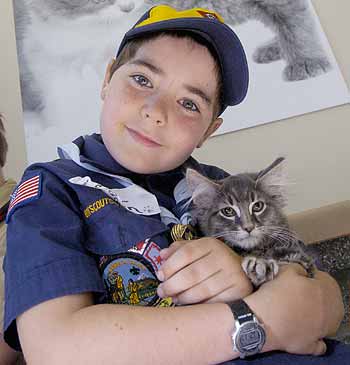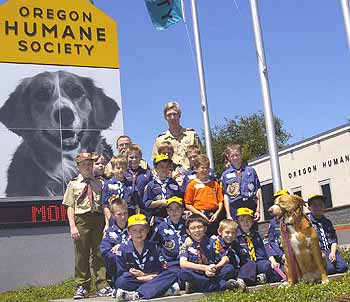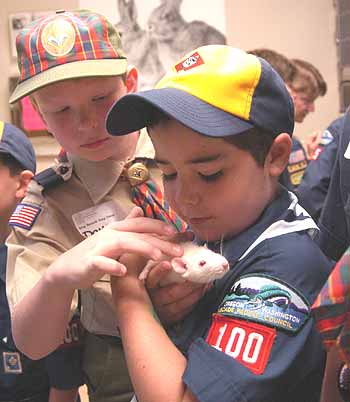Teaching Scouts to Be Kind to Animals
By Ambuja Rosen
Photographs By Michael McDermott
Boys from several Oregon packs visit a local humane society to learn empathy, compassion, and respect.
- How a Humane Society Helps Animals
- Web Exclusive: Activities for Scouts of All Ages
- Web Exclusive: Resources
- Web Exclusive: Preventing Dog Bites
 Bear Cub Scout Morgaen Schall makes friends with a feline resident of the Oregon Humane Society. |
"We've got your fur fix," the electronic billboard flashes in rousing red to cars whizzing past the Oregon Humane Society (OHS) in Portland.
Today, 19 Cub Scouts and Webelos Scouts from the Cascade Pacific Council will heed this call and be of loving service to as many as 270 dogs, cats, and other mammals.
By the end of the day, they'll be dog-biscuit makers, kitty-toy craftsmen, canine-clothing designers, and advertising-slogan writers for homeless animals who can't speak for themselves. They'll also learn a lot about being kind to animals.
OHS is the perfect setting for humane education—teaching people to treat animals with respect. In 2004, it took in more than 11,500 animals, saving 87 percent of them by placing them in homes or with re-homing agencies or returning them to their owners.
The 136-year-old charity rehabilitates animals, physically and emotionally. It also reaches out to the community: investigating complaints of pet abuse and neglect, counseling perplexed pet owners on its behavior help line, and visiting schools to teach kids that animals' feelings are important.
Lessons in empathy
Inside the education hall, Carol Shiveley, OHS's manager of education, hands each Cub Scout a piece of paper. "Don't say anything. Only make the sound of the animal written on your paper."
Creative howls, meows, squeals, and neighs fill the room. Shiveley, who was once a Cub Scout den leader, smiles. "Now do you see what animals have to go through to try to communicate with us? And then we usually respond, 'What?'"
Ginger, Shiveley's medium-size, gentle "education dog," startles everyone by barking loudly when another dog enters the room.
"Why did Ginger get upset?" Shiveley asks. The Scouts guess correctly—territory and protection.
"Have you ever seen dogs run to the fence and bark? They're trying to protect their territory and owners," Shiveley explains.
 Boys and leaders from four Portland packs had a memorable (and educational) visit to their state's largest animal shelter. |
Animal-friendly lessons like Shiveley's are touted by an increasing number of teachers and animal shelter professionals.
Dr. Steve Gross, a clinical psychologist in Amherst, Mass., is one proponent of such education.
"From clinical observations, we know that kids who sympathize with animals seem much more able to resolve problems nonviolently than kids who don't," he says. "On the other hand, some studies indicate that kids who are cruel to animals have a much higher probability of becoming violent toward people."
He adds, "The kinder toward animals that Scouting activities are, the better. Kinder activities build better character in youngsters."
After the ruffled Ginger reverts to her normally placid self, Shiveley explains to the Scouts that OHS is there for animals that have no homes.
Most animals are brought in to OHS by their owners, and the typical reasons for doing so are: "We're moving." "I don't have enough time for this animal." "It costs too much money to keep him." "The landlord will kick us out if we don't get rid of him."
If people will think more about the responsibility involved in having an animal or prepare better for the relationship, many probably would not be giving up a family member.
By now, many of the Scouts have petted Ginger and fed her treats. Shiveley uses the moment to teach them how to be good citizens for animals.
"If Ginger was out in the yard alone, skinny and without food or water, what would you do?" she asks. She role-plays a humane investigator while one of the Scouts pretends he's concerned and phoning her about such a dog.
"If you saw someone really hurting a dog or cat, that would be cruelty," Shiveley explains, telling the boys that OHS should be called in such situations in order for the society to check on the incident. The boys nod their heads. (See sidebar.)
Cuddles and kisses
The Scouts are now ready for the most enjoyable part of their lesson: hobnobbing with the animals.
Shiveley leads them past a yard where two dogs are playing with a ball and into a room with kennels of kittens.
 Dave Ellson and Morgaen Schall cuddle with a furry rodent in the area for rabbits and rats. |
After a chorus of "Oooohhhs" from the boys, she explains that there is one way families can help animals even if they can't adopt them: by serving as a foster home for a mama cat and for her newborn kittens until they are old enough to be put up for adoption.
"Which cat is the most unhappy?" Shiveley asks as Scouts move on to eight adult cats, each in its own cage. The boys correctly point to the one hiding under a paper.
After the boys pet and play with other cats, Shiveley announces, "Let's visit the dogs now," and gets a "Whoopee!" from the Scouts.
Despite the doggy odor that greets them as they enter the kennels, the boys pet one eager-faced, waggy-tailed pooch after another. Entering the puppy area, they chime another group "Oooohhh!"
When the cuddling is over, the group returns to the education hall, where Shiveley explains the do's and don'ts of interacting with dogs, including the all-important topic of how not to get bitten.
As a final lesson, she directs the Scouts to lie down curled up like a rock. She adds a bit of realism by putting a stuffed dog in front of each boy's face.
"This is how to protect yourself in the rare instance you feel a dog might attack you."
For a lesson on avoiding cat bites and scratches, the Scouts pet a stuffed toy cat gently and learn how to let a cat come to them. Some boys push the toy cat in front of Ginger, meowing loudly.
"Should you make screeching animal noises around dogs?" Shiveley asks.
"No!" the Scouts chorus.
"That's teasing," Shiveley agrees, "and it could make a dog upset."
Also, when a dog or cat bites or scratches a person, the animal may be taken from its home.
It's time to make gifts for the animals, and the Scouts move to different activity tables. One is soon covered with handmade signs for the cages. (One sign says, "I'll be your new best friend. I'm frightened and I want to go home.")
Multicolored bandanas—to make homeless dogs look pretty enough to take home—are drying as some Scouts feed biscuits they helped make to kennel dogs; others carry rainbow wand toys they made to cats.
One Scout admits that he once hit his dog. "From today on, I'll be kinder to my dog and give her more treats. I won't hit her again."
Robin Lee, a den leader of Pack 20, St. Philip Neri Catholic Church, says she wants her entire pack to experience the OHS program. (Today's other Cub Scouts are from Pack 18, chartered to Peace Lutheran Church, and Pack 100, of Fremont United Methodist Church.)
Shiveley, who is current president of the Association of Professional Humane Educators, says: "Children who are cruel to animals have different motivations. Sometimes they're trying to impress peers or parents by following their example.
Sometimes they're angry and want to lash out at the nearest thing. Sometimes they're trying to feel powerful and in control over something vulnerable. "Here at OHS, we teach children...how powerful it is to be kind."
Freelance writer Ambuja Rosen writes from Ashland, Ore.
How a Humane Society Helps AnimalsThe Oregon Humane Society is the Beaver State's largest animal shelter. Because of its programs: Many more people keep their pets for life. "More and more, people who come here to drop off animals are deciding to keep them instead," says Kathy Covey, OHS's communications manager. "We teach them to have realistic expectations, and that animals don't do things to get back at people. And we offer practical tips to resolve frustrations that people have with pets." OHS also advises people on its help line. Typical questions: "How do I get my dog or cat to stop urinating on the rug? Or to stop being so aggressive? How do I housebreak my dog or cat?" Or "Help! My dog freaks out when I leave him alone." And "How can I introduce my new pet so he gets along with others?" Fewer animals are abused and neglected. And more abandoned animals get a second chance. "I drove by horses today that look like they're starving." OHS takes complaints like this about abuse, neglect, or abandonment of just about any pet or farmed animal, including fish. A neighbor's dog chained without shelter... An abandoned boa constrictor found in an apartment... Complainers don't have to give their names. "Our two humane investigators educate the animal owners in question, offering solutions and directing them to resources," Covey says. But sometimes they serve search warrants, write citations, arrest people, and submit cases to court. Guilty animal owners might go to jail—like the woman who caged her rabbit in such a hot place that it died. Some must pay fines, do community service, or cover expenses—like the man who had to pay OHS to rehabilitate his nearly starved ducks. Abusers may also get probation. Some are banned from keeping animals—sometimes for life. Generally, the imperiled animals go to an agency or organization. They're kept there for life, adopted out, returned to their owner (if the charge or case is dismissed), or euthanized. More people know how to treat their animals with kindness and respect. OHS visits schools, service clubs, and even senior citizen centers to teach people how to understand their pets and care for them responsibly. One or two instructors bring an "education dog" into classes (kindergarten through high school) 80 times a year. For the younger children, they teach simple things, like how animals feel and how to play with them gently. Older students learn about taking responsibility for their pets and what they can do to help animals in general. High school kids learn about careers helping animals. —A.R. |
Web Exclusive: Activities for Scouts of All Ages
—A.R. |
Web Exclusive: ResourcesTo find humane educators:
To find animal sanctuaries—
To find your nearest animal shelters: www.1888pets911.org or call 888-PETS911 and punch in your zip code. To find wildlife rehabilitators:
Humane education materials:
—A.R. |
Web Exclusive: Preventing Dog BitesMost dogs have never bitten anyone. But bites happen, and most can be prevented. The Oregon Humane Society shares these safety tips: All dogs (even your own)—
Dogs other than yours—
Dogs you are not familiar with—
—A.R. |
September 2005 Table of Contents
Copyright © 2005 by the Boy Scouts of America. All rights thereunder reserved; anything appearing in Scouting magazine or on its Web site may not be reprinted either wholly or in part without written permission. Because of freedom given authors, opinions may not reflect official concurrence.